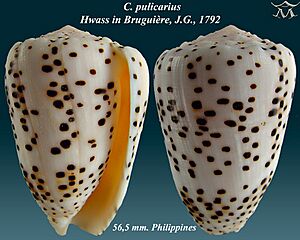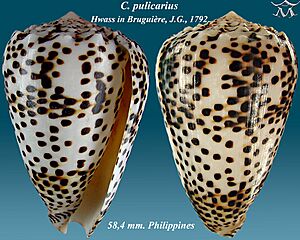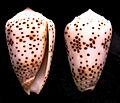Conus pulicarius facts for kids
Quick facts for kids Conus pulicarius |
|
|---|---|
 |
|
| Apertural (left) and abapertural (right) views of a shell of Conus pulicarius | |
 |
|
| Scientific classification | |
| Synonyms | |
|
Conus pulicarius, often called the flea-bitten cone, is a fascinating type of sea snail. It's a marine gastropod mollusk from the Conidae family, also known as the cone snails.
These snails are predatory, meaning they hunt other animals for food. They are also venomous. Because of their venom, it's very important to be careful around live cone snails. It's best not to touch them at all.
What Does the Flea-Bitten Cone Look Like?
The shell of the flea-bitten cone can be anywhere from about 30 mm (1.2 inches) to 75 mm (3 inches) long. Its shell is usually white. It has many square-shaped spots that are dark chocolate brown or almost black. Sometimes, these spots are so close together that they form two bands around the shell.
The top part of the shell, called the spire, has small bumps. The outer layer of the shell is very thin and clear, almost like glass.
Where Do Flea-Bitten Cones Live?
This marine snail lives in the warm waters of the Central and Western Pacific Ocean. You can find them in places like Polynesia (but not the Marquesas Islands), Cocos (Keeling) Island, New Guinea, and parts of Australia. In Australia, they are found in the Northern Territory, Queensland, and Western Australia.
Gallery







